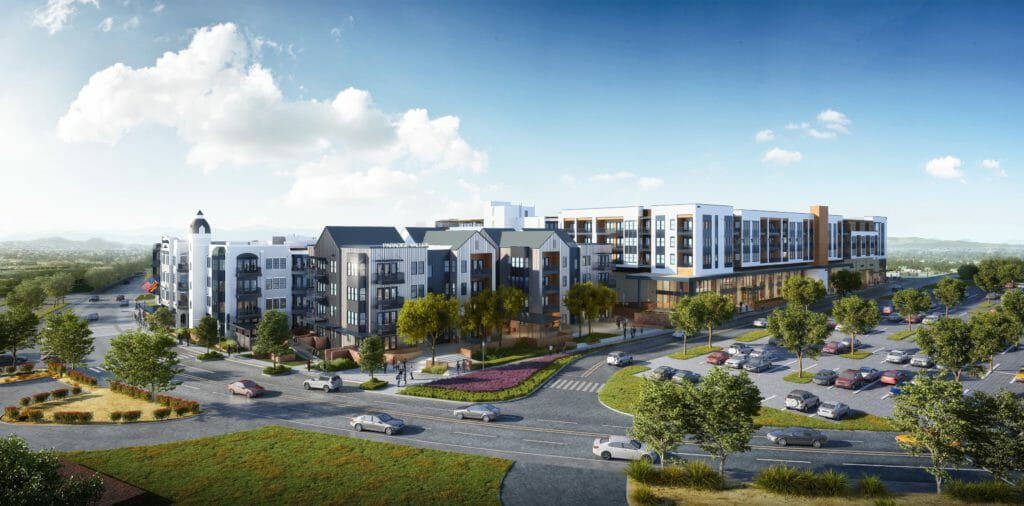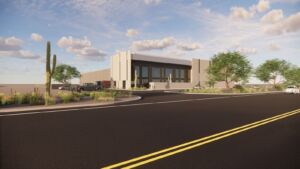Known as the Valley of the Sun, Phoenix is one of commercial real estate’s hottest markets. With a current population of over 4.6 million, a 1.48 percent increase from 2021, the Phoenix metro is packed with abundant job growth, consumer spending, and investment opportunities. Throughout the U.S., Phoenix had the largest absolute increase in population growth between 2010 and 2020 and reported the fastest growth rate among America’s biggest cities, according to the New York Times. Beyond impressive population stats, Phoenix also boasts a business-friendly environment with limited government interference and low taxes. Lastly, the Valley offers sprawling submarkets at reasonable prices. Suburbs like Buckeye grew 80 percent in ten years and provide development opportunities not seen in dense coastal markets. In all, Phoenix has become a treasure for commercial real estate investors, but with great success comes great challenges. As the aftereffects of COVID-19 become clear and sectors begin to shift, investors will need to evaluate where in the Valley to plant capital, what type of products best suit their needs, and what economic and consumer trends Phoenix is experiencing. Here is a look at the 2023 Phoenix commercial real estate outlook and opportunities.
READ ALSO: Here are the people to know in commercial real estate for 2023
READ ALSO: 12 projects under construction in Downtown Phoenix
The Multifamily Market
2020 spurred historical growth for Phoenix’s multifamily market that continued into 2021 and early 2022. The influx of movers into Phoenix caused a massive shift in demand for multi-housing properties, forcing developers to ramp up new supply quickly. But now, in late 2022, the absorption rate is moderating, and supply is still accelerating, causing the metro’s vacancy rate to reach 7.9 percent, a two percent increase from Q1 2022. Around the summer of 2021, Phoenix averaged 15 to 20 transactions per week, with fewer properties available. As of September 2022, Phoenix is averaging one to four transactions and five to 10 new properties entering the market per week. The development pipeline, specifically for luxury units, is heavily outpacing demand, as renters seek more affordable, smaller units to combat rising living costs. Although still impressive, the market’s current rent growth of 12 percent is much lower than the market’s rate of 27 percent in early 2022; most likely a result of slowing demand and lower lease renewal rates.
Investment Opportunities
With high vacancy rates, slowing rent growth, and overwhelming supply, Phoenix multifamily investors may be looking at a game of “hot potato.” Certain assets could hold dangerous consequences and cause trouble for owners as demand stalls, and renter expectations change.
Investors are striving to find first-generation value-add deals which are few and far between, as 1,361 properties have traded over the last five years, representing 36 percent of the market. The biggest opportunity for investors will be re-strategizing and adding value to operations rather than adding extensive interior and exterior renovations. Investors should focus on improving the bottom-line net operating income, whether that be turning the rent roll or re-capturing market rents. Other ways to increase the bottom line include adding other income-producing initiatives such as parking, pet rent, or laundry while simultaneously focusing on cutting down ownership expenses. During uncertain markets, improving existing properties will ultimately create the most value for multifamily investors.

2023 commercial real estate outlook: Industrial
By John Stroud
Two main components can be attributed to Phoenix industrial’s monumental performance over the last two years, rent growth and low supply. With out-of-state investors flooding the Valley and delayed development timelines, buyers and tenants are being forced to pay premium pricing on industrial properties. As of August 2022, the asset class’s annual rent growth rate was 16.5 percent, much higher than the national average. Market sale price per square foot also accelerated, reaching $168, a 19 percent increase year-over-year.
Another attribute of industrial’s performance is its diversification of property types and reach across industries. Warehouse and manufacturing space proved to be pivotal during the pandemic, but the lack of supply caused almost all industrial properties to increase in value. Tenants began adapting to the market, leasing spaces previously deemed unsuitable because the options were limited.
Rising construction costs, labor shortages, and rising interest rates are all affecting commercial real estate development, but Phoenix industrial is still strong, and outlook remains positive.
As more facilities are built around the Valley, land constraints, have appeared. In-demand neighborhoods like Scottsdale Airpark, an 8.6 square mile area with over 2,900 businesses, have little land left to develop, a problem that was nowhere near fruition a few years ago. Phoenix also saw a shift in building sizes as large Fortune 500 companies started moving into the market. To accommodate the influx, developers focused on producing big-box industrial properties and scaling back on smaller facilities. Once again, the lack of availability has pushed pricing up, and small industrial properties are going for top dollar. In addition, land constraints have spurred developers to look into repurposing existing structures as new builds become more expensive and regulated.
Investment Opportunities
The biggest obstacle facing Phoenix industrial investors is rising prices and the rat race of competitive offers coming in across all product types. Arizona gained popularity due to its affordability compared to nearby coastal markets, but with the current lack of supply and unbalanced demand, that pricing gap is narrowing. Investors should consider growing submarkets like North Phoenix, and the East and West Valley to obtain assets at a lower price per square foot with a potential upside. However, the further out, the greater risk as some regions bring fluctuating vacancy and less leasing demand. Another point to keep in mind while investing in Phoenix industrial is the amount of supply waiting to enter the market is higher than the majority of the country, which potentially could limit an owner’s leverage to raise rents once vacancy heightens.
The Self-Storage Market
By Ben Tracy
The self-storage asset class climbed the ranks rapidly at the start of the pandemic and has continued its dominance throughout the U.S. Phoenix boasts one of the most vital self-storage pipelines; with 13.3 percent of existing inventory underway, making it a top five metro for development in the nation. Self-storage rates have remained high, although operators are predicting an increase in move-outs in the second half of 2022 as workers return to offices and the Phoenix housing market slows. However, the average length of stay for renters has increased, helping owners secure stable and lucrative income. According to Yardi Matrix, total revenue for self-storage products is increasing by double-digit percentages nationally.
Investment Opportunities
As with any real estate, the most crucial factor self-storage investors should consider when it comes to the 2023 commercial real estate outlook is location, location, location. Phoenix is seeing a slight shift in consumer trends but still offers plenty of valuable opportunities within the storage market. Single-story facilities with larger units see longer-term tenancy and strong demand throughout the Valley. These types of properties are comparable in strength to three-story Class A climate-controlled facilities. Phoenix is also a thriving market for boat and RV storage facilities. With most of the new housing being in HOA communities, homeowners need a place to store recreational vehicles and boats due to the strict storage and parking policies in regulated communities.

The Retail Market
By Alex DeSoto
The thriving local job economy combined with the market’s population growth has helped Phoenix’s retail sector quickly recover from the impact of COVID-19 and increase its popularity among investors. Leasing volume is substantial, with 4.4 million square feet absorbed within the last 12 months, according to CoStar. Smaller, niche tenants are performing well and rapidly growing. Boutique gyms such as F45 or popular local coffee joints like Dutch Bros and Black Rock Coffee are storming the Valley and offer investors a smaller retail footprint solution. Rents are steadily increasing and are above the national average, as Phoenix’s same-store asking rents increased 7.1 percent year-over-year while the U.S. average increase is 4.3 percent.
Investors are entering the market as new development and redevelopment projects pop up across the region, especially in growing submarkets. One of the largest retail redevelopments, PV, a mixed-use complex set to complete its first phase by 2024, is in North Phoenix and will offer a 400-unit multifamily building in addition to various retail fronts, hospitality, and entertainment venues. With growing opportunities and increased competition, pricing has increased, reaching an average of $250 per square foot.
Investment Opportunities
Phoenix’s tremendous rent growth has driven values well beyond what most experts had predicted. Fortunately, continued growth is expected as the population and retail demand continue to increase, meaning investors should look to take advantage of the market conditions.
When it comes to the 2023 commercial real estate outlook, it’s important to keep in mind the majority of tenants in Phoenix are food and beverage, meaning the product type is performing well but could become oversaturated. Overall, consumers are craving a more personal and experiential shopping, dining, and workout experience, which means some brands will cater to new generations better than others. Boutique fitness facilities, quick-service restaurants, and technology-savvy retailers will continue to gain popularity and offer a secure and profitable business model for investors.
Phoenix commercial real estate is healthy and bountiful but is shifting as it nears late 2022. It is essential that investors work with a specialized and knowledgeable agent to understand what product types fit long-term financial, management, and portfolio goals, in addition to what parts of the Valley present thriving opportunities.
Authors: The 2023 commercial real estate outlook was written by John Stroud, Kyle Iman, Ben Tracy and Alex DeSoto, who work with Matthews Real Estate Investments Services, a commercial real estate investment services and technology firm, holds recognition as an industry leader in investment sales, leasing, and debt and structured finance. For more information, visit www.matthews.com.




